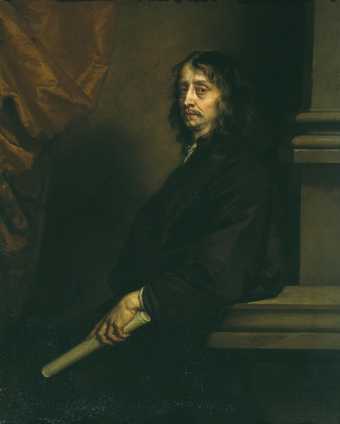
Fig.1
Sir Peter Lely 1618–1680
Frans Mercurius van Helmont
1670–1
Oil paint on canvas
1232 x 1010 mm
N03583
This painting is in oil paint on canvas measuring 1232 x 1010 mm. The single piece of plain, coarsely woven, linen canvas has approximately 15 vertical and 12 horizontal threads per square centimetre. There is cusping of the canvas weave on all edges, indicating that we have the original or near-original dimensions of the painting. 1 Evidence from the X-radiograph (fig.2) would appear to confirm Walpole’s note, that the painting was in poor condition when he found it at Ragley Hall in 1758 and was ‘brought up to have repaired’ (‘brought up’ probably meaning ‘brought to London’). A roughly triangular piece of canvas measuring about 660 x 80 mm is missing from the centre of the lower edge, and much paint has been lost in a broad vertical line running at right angles from this canvas loss to the sitter’s chest. Large nail-holes in the canvas along the edge of the loss indicate that this part of the painting was tacked to the front of the stretcher for some time after its lower edge had been damaged.
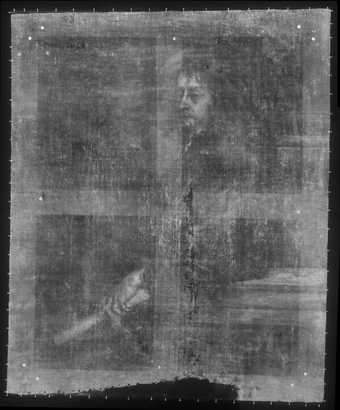
Fig.2
X-radiograph of Frans Mercurius van Helmont
The whole painting is now reinforced with a double lining. Although both linings have glue composition – as the adhesive and are on similar, closely woven canvases – they are probably not coeval. Close examination of the edges indicates that the painting’s original tacking margins had been removed by the time of the first lining, which in turn was cropped at the turnover edges before the second lining was applied. From the style of the stretcher, the second lining probably dates from the late nineteenth or early twentieth centuries.
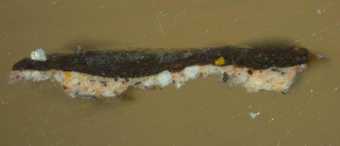
Fig.3
Cross-section through the torus of the column, photographed at x160 magnification. From bottom to top it shows: beige ground; lilac-grey paint of column; varnish residues
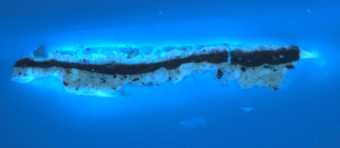
Fig.4
The same cross-section as fig.3 photographed in ultraviolet light
The ground is opaque greyish beige, about 90 microns thick (figs.3 and 4). It is composed of lead white, chalk, charcoal black, red and yellow ochres, and glassy particles all bound together in linseed oil.2 As we have found consistently in this study of Lely, no underdrawing is discernible.
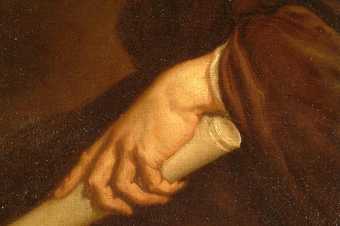
Fig.5
Detail of hand and scroll, showing brown underpaint left visible as the shadows and outlines
Microscopic examination of the face and hands indicates that the features were probably first delineated with opaque, chestnut brown paint, which remains visible as the shadows (fig.5). Using other work by Lely as evidence, the rest of the composition was probably sketched in roughly with thin reddish brown paint.3
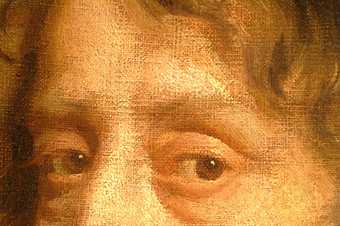
Fig.6
Detail of the sitter’s eyes
No significant underpainting is evident from microscopic examination of the painting’s surface or from cross-sections. The painting was created with opaque, wet-in-wet tones mixed up on the palette and worked into one another on the prepared surface of the support. The paint is well bound in oil and was used thickly with decisive brushwork in the face, hands, neck-cloth and scroll (figs.6 and 7).

Fig.7
Detail of the sitter’s mouth
The colours were made mainly from mixtures of ochres, umbers, lead white and chalk with copious amounts of the translucent brown, Cologneearth, added to most of them. The light flesh tone at the knuckle of the sitter’s hand contains lead white, red ochre, yellowish brown ochre, chalk, lead tin yellow orNaplesyellow, smalt, black and Cologne earth. The golden yellow of the curtain was made fromNaplesyellow mixed with two types of yellow lake, vermilion, black, chalk and glassy particles; its binding medium is linseed oil.
May 2003
